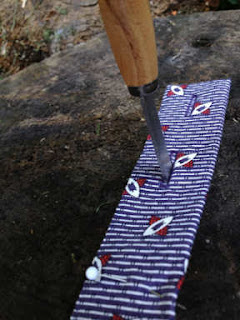 I needed a new apron for when I get to play with the Bake Oven , when I volunteer at the heritage village. I've been borrowing one from the costume department but they are all a bit too large and a bit too frilly for me. I'm short and some of the ruffly things are just too overwhelming to work in. As well, they're all white, which is more of a fancy apron that a work apron for the time of 1865 - 70. I decided to make one that actually fit me.
I needed a new apron for when I get to play with the Bake Oven , when I volunteer at the heritage village. I've been borrowing one from the costume department but they are all a bit too large and a bit too frilly for me. I'm short and some of the ruffly things are just too overwhelming to work in. As well, they're all white, which is more of a fancy apron that a work apron for the time of 1865 - 70. I decided to make one that actually fit me.Most work aprons that I've seen from that time period are pinner aprons, which use pins to hold up the bib, rather than a band or tie. As well, work aprons really did tend to be colouful and patterned to hide the dirt. I can say that when I work the oven, I get soot on my apron almost immediately, which shows up on the white most dramatically.
The only fabric store left in town has a huge quilting department which does stock a few period reproduction prints. While I wasn't in love with this pattern at first, the price was definitely right and the bolt markings designated it as 1863, which was pretty close to the time period I was after. Pretty much everything else was later and a few were earlier.
It was pretty easy to sew up. I marked and cut the pattern yesterday and sewed it together this afternoon. I combined two different "patterns" for this project. The first instructions were from The Sewing Academy, from the section of free patterns. The second was from World Turned Upside Down. I do wish I'd gathered the bib a bit, but otherwise it's turned out quite nicely.
The apron has buttons at the back, rather than ties. I couldn't find my little piece of wood that I normally keep in my sewing box, when I needed to cut the waistband button holes, so I took the apron out to the chopping block. I found this little buttonhole chisel a while back and it cuts the cleanest buttonholes ever, way nicer than using snips or scissors. It's one of those right tools for the job and makes a professional, very clean slice.

I put two patch pockets on the apron. I've only seen a couple of that era aprons with large patch pockets, but there are a few. It's the one thing that I find myself missing, so I added them. I did match the patterns though, so they are more than a bit discrete. Here is the finished apron, pinned to the barn. By the time I'd finished the apron, I loved the fabric and could have seen a dress made of this. However I can't have a dress and an apron made of the same fabric, so I'll have to keep looking.
I purchased 3 yards of fabric but have 3/4 of a yard leftover, so I guess that means I've started collection reproduction fabrics for a quilt!
Rudbekia Goldsturm is one of my favourite flowers. Despite it being yellow, it blooms for a very long time and at the end of the summer, when a lot of the perennials have already had their 15 minutes of fame. Sometimes I harvest it for dye plants, but it makes a rather soft, greenish colour and I do think it's value really is in the garden rather than the dye pot.


funny, how different the pattern on the fabric looks in a close-up! I am not an apron fan, but one without pockets would be even worse for me - where to stuff things in between? and I have a rudbeckia, too (haven't tried it for dyeing), but I cannot even see flower buds - yet!
ReplyDelete